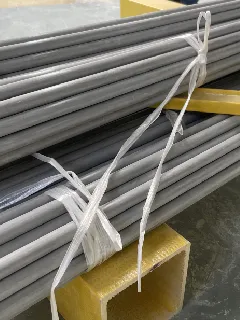loading...
- No. 9, Xingyuan South Street, Dongwaihuan Road, Zaoqiang County, Hengshui, Hebei, China
- admin@zjcomposites.com
- +86 15097380338
- Welcome to visit our website!
Exploring the Benefits and Applications of FRP U Channels in Construction
Understanding FRP U Channels Properties, Applications, and Benefits
Fiber Reinforced Polymer (FRP) materials have revolutionized several industries, primarily due to their strength-to-weight ratio, resistance to corrosion, and overall durability. Among various forms of FRP products, the FRP U channel is particularly noteworthy for its versatility and applications across multiple sectors. This article delves into the properties, applications, and benefits of FRP U channels.
Properties of FRP U Channels
FRP U channels are structural elements designed in the shape of the letter 'U', which allows for multiple functions such as support, framing, and guidance of loads. One of the key properties of FRP is its lightweight nature, making it easier to handle and install compared to traditional materials like steel or concrete. Typically, FRP U channels exhibit excellent mechanical strength, providing high tensile and compressive strength, which makes them suitable for structural applications.
Moreover, FRP materials are inherently resistant to environmental factors such as moisture, chemicals, and UV radiation. This property ensures that FRP U channels maintain their integrity and performance over time, considerably reducing maintenance costs and increasing longevity. The thermal and electrical insulation properties of FRP also make these channels suitable for applications in environments where conductivity or heat transfer is a concern.
Applications of FRP U Channels
The versatility of FRP U channels allows them to be utilized in various industries. Some of the prominent applications include
1. Construction and Civil Engineering FRP U channels are increasingly used as structural components in bridges, buildings, and various infrastructures. Their lightweight nature simplifies transportation and installation, while their durability allows for reduced maintenance.
2. Marine Industry Due to their corrosion resistance, FRP U channels are ideal for use in shipbuilding and coastal structures. They can withstand harsh marine environments where traditional materials would quickly degrade.
frp u channel

3. Transportation In the transportation sector, FRP U channels are used for guiding systems, such as in railway tracks or roadside barriers. Their strength and lightweight properties contribute to safer and more efficient transport systems.
4. Electrical and Telecommunications The insulation properties of FRP U channels make them suitable for housing cables and shielding sensitive equipment from electromagnetic interference.
5. Chemical Processing In chemical plants, where exposure to corrosive substances is a daily reality, FRP U channels provide robust support without the risk of deterioration that metal options face.
Benefits of Using FRP U Channels
The adoption of FRP U channels provides numerous advantages. First, their resistance to corrosion reduces the need for protective coatings, leading to lower lifecycle costs. Second, the lightweight aspect of FRP U channels contributes to less energy consumption during transportation and installation processes.
Additionally, the aesthetic appeal of FRP materials allows for design flexibility, enabling architects and engineers to create innovative and functional structures without the constraints often posed by traditional materials. Lastly, FRP U channels are often produced with sustainable practices, making them an environmentally friendly alternative.
Conclusion
FRP U channels exemplify the next generation of building materials, offering a combination of strength, versatility, and durability that meets the evolving needs of various industries. Their resistance to environmental factors, low maintenance requirements, and ease of installation further bolster their appeal. As industries continue to seek sustainable and cost-effective solutions, FRP U channels are set to play an increasingly important role in the future of construction, engineering, and design.
-
The Rise of FRP Profiles: Strong, Lightweight, and Built to LastNewsJul.14,2025
-
SMC Panel Tanks: A Modern Water Storage Solution for All EnvironmentsNewsJul.14,2025
-
GRP Grating: A Modern Solution for Safe and Durable Access SystemsNewsJul.14,2025
-
Galvanized Steel Water Tanks: Durable, Reliable, and Ready for UseNewsJul.14,2025
-
FRP Mini Mesh Grating: The Safer, Smarter Flooring SolutionNewsJul.14,2025
-
Exploring FRP Vessels: Durable Solutions for Modern Fluid HandlingNewsJul.14,2025
-
GRP Structures: The Future of Lightweight, High-Performance EngineeringNewsJun.20,2025
